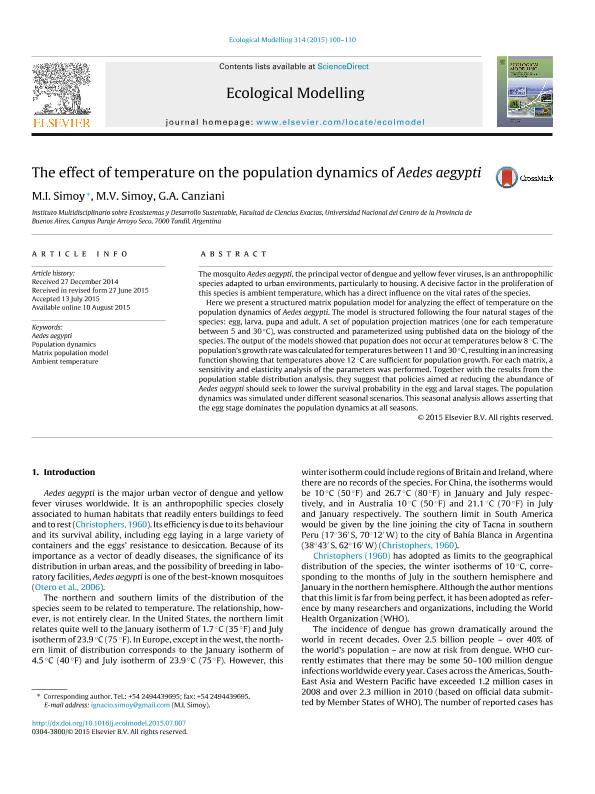Mostrar el registro sencillo del ítem
dc.contributor.author
Simoy, Mario Ignacio

dc.contributor.author
Simoy, Maria Veronica

dc.contributor.author
Canziani, Graciela Ana

dc.date.available
2022-12-05T11:49:26Z
dc.date.issued
2015-10
dc.identifier.citation
Simoy, Mario Ignacio; Simoy, Maria Veronica; Canziani, Graciela Ana; The effect of temperature on the population dynamics of Aedes aegypti; Elsevier Science; Ecological Modelling; 314; 10-2015; 100-110
dc.identifier.issn
0304-3800
dc.identifier.uri
http://hdl.handle.net/11336/180100
dc.description.abstract
The mosquito Aedes aegypti, the principal vector of dengue and yellow fever viruses, is an anthropophilic species adapted to urban environments, particularly to housing. A decisive factor in the proliferation of this species is ambient temperature, which has a direct influence on the vital rates of the species.Here we present a structured matrix population model for analyzing the effect of temperature on the population dynamics of Aedes aegypti. The model is structured following the four natural stages of the species: egg, larva, pupa and adult. A set of population projection matrices (one for each temperature between 5 and 30. °C), was constructed and parameterized using published data on the biology of the species. The output of the models showed that pupation does not occur at temperatures below 8. °C. The population's growth rate was calculated for temperatures between 11 and 30. °C, resulting in an increasing function showing that temperatures above 12. °C are sufficient for population growth. For each matrix, a sensitivity and elasticity analysis of the parameters was performed. Together with the results from the population stable distribution analysis, they suggest that policies aimed at reducing the abundance of Aedes aegypti should seek to lower the survival probability in the egg and larval stages. The population dynamics was simulated under different seasonal scenarios. This seasonal analysis allows asserting that the egg stage dominates the population dynamics at all seasons.
dc.format
application/pdf
dc.language.iso
eng
dc.publisher
Elsevier Science

dc.rights
info:eu-repo/semantics/openAccess
dc.rights.uri
https://creativecommons.org/licenses/by-nc-sa/2.5/ar/
dc.subject
AEDES AEGYPTI
dc.subject
AMBIENT TEMPERATURE
dc.subject
MATRIX POPULATION MODEL
dc.subject
POPULATION DYNAMICS
dc.subject.classification
Matemática Aplicada

dc.subject.classification
Matemáticas

dc.subject.classification
CIENCIAS NATURALES Y EXACTAS

dc.title
The effect of temperature on the population dynamics of Aedes aegypti
dc.type
info:eu-repo/semantics/article
dc.type
info:ar-repo/semantics/artículo
dc.type
info:eu-repo/semantics/publishedVersion
dc.date.updated
2022-12-05T11:03:54Z
dc.journal.volume
314
dc.journal.pagination
100-110
dc.journal.pais
Países Bajos

dc.journal.ciudad
Amsterdam
dc.description.fil
Fil: Simoy, Mario Ignacio. Universidad Nacional del Centro de la Provincia de Buenos Aires. Facultad de Ciencias Exactas. Instituto Multidisciplinario sobre Ecosistemas y Desarrollo Sustentable. Grupo de Ecología Matemática; Argentina. Consejo Nacional de Investigaciones Científicas y Técnicas. Centro Científico Tecnológico Conicet - Tandil; Argentina
dc.description.fil
Fil: Simoy, Maria Veronica. Universidad Nacional del Centro de la Provincia de Buenos Aires. Facultad de Ciencias Exactas. Instituto Multidisciplinario sobre Ecosistemas y Desarrollo Sustentable. Grupo de Ecología Matemática; Argentina. Consejo Nacional de Investigaciones Científicas y Técnicas. Centro Científico Tecnológico Conicet - Tandil; Argentina
dc.description.fil
Fil: Canziani, Graciela Ana. Universidad Nacional del Centro de la Provincia de Buenos Aires. Facultad de Ciencias Exactas. Instituto Multidisciplinario sobre Ecosistemas y Desarrollo Sustentable. Grupo de Ecología Matemática; Argentina
dc.journal.title
Ecological Modelling

dc.relation.alternativeid
info:eu-repo/semantics/altIdentifier/url/https://www.sciencedirect.com/science/article/abs/pii/S0304380015003130
dc.relation.alternativeid
info:eu-repo/semantics/altIdentifier/doi/http://dx.doi.org/10.1016/j.ecolmodel.2015.07.007
Archivos asociados
